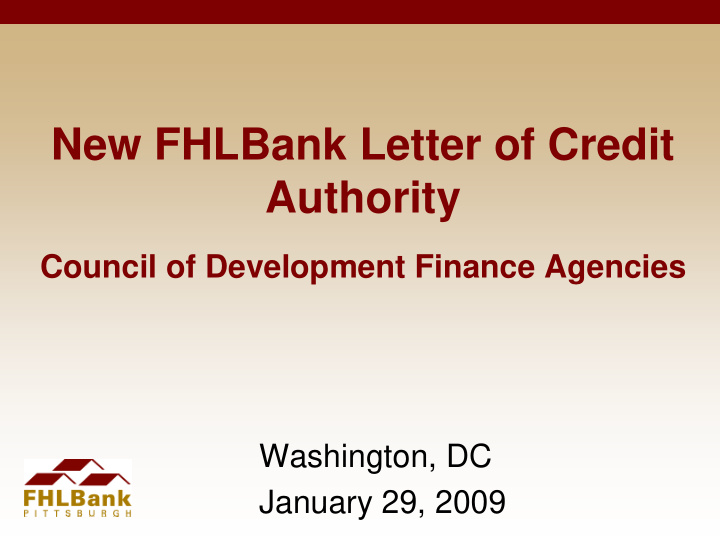



New FHLBank Letter of Credit Authority Council of Development Finance Agencies Washington, DC January 29, 2009
Agenda • FHLBank System Background • Eligible Purposes • New Authority • Types of: –LOCs –Bond Deals/Project –Bond Structures • Terms/Pricing • Impact of FHLBank LOC • Example of a Bond Deal
Mission of the FHLBank System We assure the flow of credit and services that enhance members’ businesses and vitalize their communities. • A range of housing, community and economic development, and general banking needs. • A proper balance between the Bank’s responsibilities to members and the general public.
FHLBank System FHLBank System
Our Past Our Past • 1932 FHLBank Act – 12 Cooperative Banks – Government-Sponsored Enterprises (GSEs) – Tax Exempt – Promoting Housing Liquidity and Regulation for the S&L Industry
FHLBank Business • Over 8,000 financial institutions are members of the FHLBank System • Advances, or loans to members, are the main product • Affordable Housing Program • Secondary market mortgage programs • Letters of credit
Types of Letters of Credit • Standby Letter of Credit – FHLBank LOC performs if member doesn’t perform its responsibilities (public unit deposits – no member LOC) • Confirming Letter of Credit – FHLBank LOC stands behind the member’s LOC – Confirms member’s LOC and improves credit rating of transaction
Types of Letters of Credit • Direct Pay Letter of Credit – FHLBank LOC stands behind the member’s LOC – FHLBank’s LOC is drawn on first for: • non-performance, • Principal and interest payments, • Other transactional charges – FHLBank recovers from member and member from Bond Trustee.
Purposes for LOC Issuance • Facilitate residential housing – Tax-exempt mortgage revenue bonds • Community and economic development transactions • Provide liquidity or funding, including public unit deposits
Public Unit Deposit LOCs • FHLBank LOC secures municipal deposits • Members take deposits from school districts, municipal governments, etc • Over the $100,000 FDIC insurance • Keeps deposits working in communities • Pittsburgh volume outstanding – $5.6B • Fifty-six (56) Users
Housing and Economic Recovery Act of 2008 Authority to issue Letters of Credit to support Community Development for tax-exempt bond transactions (sunsets the end of 2010): Must meet one of the tests under the CICA regulation 1. Income eligible housing; 2. 100% of area median family income; 3. If rural project – 115% of area median family income; 4. Small business test; 5. Project is in a federally designated zone or community; 6. Job creation or retention or services provided by the project are to lower income individuals.
Types of Bond Deals • General Obligation • Authority • Healthcare – Hospitals, Senior Care • Education – Student Loans, Housing, Development • Industrial Development Authority • Non-Profit
Types of Projects • General Obligation – Municipal buildings – Recreation facilities • Authority – Water filtration plant – Sewage processing plant • Healthcare – Hospital additions – Senior care facilities
Types of Projects • Education – Student housing – Classroom buildings – Research centers – Interim financing
Types of Projects • Industrial Development Authority – New Manufacturing Plant – Industrial Parks – Warehouses – Stadiums • Non-profit – promote the “public good” – Facilities – Land Conservation
Types of Bond Structures • Fixed-rate – Higher credit quality issuers – Credit enhanced with bond insurance – Separate liquidity provider • Variable Rate Demand Bond (VRDB) – Credit enhanced with member LOC and FHLBank confirming LOC – LOC providers act as liquidity providers – Can be sold back to Remarketing Agent
Types of Bond Structures • Variable Rate Demand Bond (VRDB) – 7-day variable rate – sold to money funds – Interest rate tied to the SIFMA index – Issuers can purchase Interest Rate Caps
Bond Market Turmoil • Bond Insurers – Typically - AAA-rated and limited to insuring municipal bonds – Expanded to newer, higher credit risk markets, like sub-prime mortgages – Experiencing severe losses – Downgraded below AAA – Insured bonds have been downgraded – Lower credit rating of little value in new deals
Bond Market Turmoil • Letter of Credit Providers – Traditionally, large highly-rated regional banks – Banks have experienced credit rating downgrades due to mortgage exposure – Low-rated LOCs of little value – Higher-rated banks are at their LOC exposure limits
AAA-Rated FHLBank LOC can help fill the market void!!
Impact of FHLBank LOC • Alternative to AAA-rated Bond Insurance – Bond insurer downgrades • Smaller Deals – $3 - $20MM bond offerings • Rural Projects – Too small – No underwriter interest • Larger deals with member consortium
Terms of LOC • Offered in conjunction with a member institution that does the credit underwriting • Maturities up to 20 years • 3 - 5 year terms are desirable • Typical LOC is annually renewable term
How a LOC Bond Deal Works Confirming Advance Letter of Repayment Issuer/ Credit Borrower (FHLBank) Primary Draw Letter of Underwriter Credit (Member) Trustee Investors Debt Proceeds Service Remarketing Agent
Financial Benefit to Issuers 20-Year VRD Bond Example A tax-exempt yield (all-in) = 2.59% AAA tax-exempt bond yield = (0.31%) Remarketing Fee = (0.125%) + Member LOC cost = (1.75%) + FHLBank LOC cost = (0.25%) All-In Cost = (2.435%) Pricing Benefit = 0.125%
Financial Benefit to Issuers 20-Year Fixed-Rate Bond Example BBB-Rated Issuer vs FHLBank LOC BBB tax-exempt bond yield = 8.10% AAA tax-exempt bond yield = (5.10%) + Member LOC cost = (2.25%) + FHLBank LOC cost = (0.25%) All-In Cost = (7.60%) Pricing Benefit = 0.50%
Benefit of FHLBank LOC • AAA-rating – Increases universe of eligible investors • Lower interest rate for issuer – AAA yield vs A or unrated yield • Bundled services pricing – Deposits – Lockbox – Other interim lending
Deal Sourcing • Bond Underwriters • Member Institutions • Issuers • Bond Counsel • Accountants • Issuer Trade Associations
How to Get Started Contact: • Local Financial Institution • Bond Underwriter • Legal Counsel • Accountant • FHLBank
Questions?
Recommend
More recommend